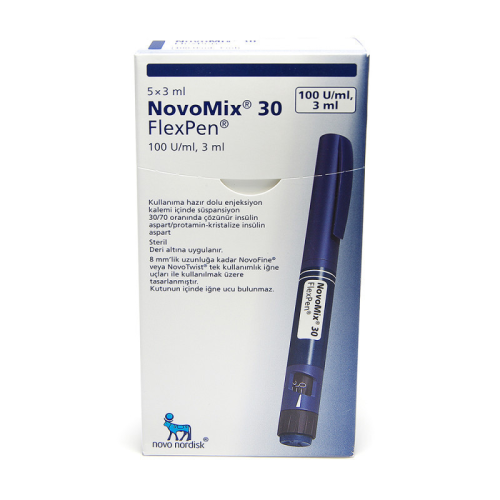Novomix 30 Flexpen
- Brand: Novo Nordisk
- Product Code: Novomix 30 Flexpen
- Availability: In Stock
-
$131.00
CLASSIFICATION
Hormone and Synthetic Substitute / Antidiabetic Agent
ACNE
No
WATER RETENTION
No
HBR
No
HEPATOTOXICITY
No
AROMATIZATION
No
MANUFACTURER
Novo Nordisk
WAREHOUSE
International Warehouse 2
SUBSTANCE
Insulin
,
Insulin is a powerful anabolic hormone produced naturally by humans and is vital for maintaining good health. While it is synthesized by the body, those with diabetes often require external insulin administration. Some athletes also use insulin to promote the growth of lean muscle tissue, but improper use can be extremely dangerous and warrants serious caution.
Although insulin is naturally produced by the body, external insulin became available in the 1920s, initially sourced from the pancreas of dogs, and later from cattle and pigs. Early on, concerns about purity were significant; however, the life-saving potential of exogenous insulin was widely recognized. For those with untreated diabetes, the risk of death is high, making the acceptance of animal-derived insulin viable despite its impurities. By the 1970s, the issue of purity had largely been addressed, leading to the introduction of synthetic insulin in 1975 by Ciba. This was further refined in 1982 with the launch of Humulin-R, an identical replica of human insulin approved by the FDA.
Roles and Characteristics of Insulin:Insulin, classified as a peptide hormone, is produced in the pancreas and plays an essential role in the regulation and utilization of glucose, amino acids, and fatty acids. It prevents the metabolic breakdown of carbohydrates, fats, and proteins.
Patients with diabetes may fall into one of two categories requiring insulin. Type I diabetes is characterized by the body's inability to produce adequate insulin, while Type II diabetes features insulin production with inadequate cellular response, often linked to obesity.
As a hormone secreted by the pancreas, insulin positively impacts the liver by promoting glycogen formation from glucose and inhibiting the conversion of non-carbohydrates into glucose. Additionally, insulin facilitates glucose uptake in cells, which can support muscle growth. Elevated insulin levels have been associated with increased protein synthesis and enhanced bone density, along with higher production of Insulin-Like Growth Factor-1 (IGF-1), another anabolic hormone similar to insulin.
Furthermore, insulin influences the increase of Luteinizing Hormone (LH) and Follicle Stimulating Hormone (FSH), which may enhance testosterone production in the body, although this effect is not particularly pronounced.
Impact of Insulin:Whether dealing with Type I or Type II diabetes, the primary effect of insulin relates to blood sugar regulation. Its potent anabolic and anti-catabolic properties make it advantageous for various athletes. However, non-medical use of insulin can lead to significant weight gain and potentially lethal outcomes if not properly managed.
Despite the risks, some athletes believe that insulin's anabolic effects are worth pursuing, provided they successfully manage body fat. Elevated insulin levels hinder the body's ability to burn stored fat, so individuals supplementing for performance must adhere to a strict, well-planned diet, cautiously regulating calorie and fat intake to ensure nutrients are stored in muscle rather than fat tissue. The optimal time to administer insulin is immediately post-exercise, accompanied by food.
When used effectively, insulin can facilitate rapid increases in lean muscle mass, but many struggle with managing body fat gain. Combining insulin with anabolic steroids and Human Growth Hormone (HGH) is often suggested in performance contexts, as this combination can enhance both muscle growth and fat management.
Potential Side Effects of Insulin:The primary concern surrounding insulin use involves hypoglycemia, which can become a significant risk in performance settings. For diabetic patients, proper dosing usually mitigates this risk, but it can be more challenging for non-diabetics using insulin.
Hypoglycemia occurs when blood glucose levels drop too low and is the most common side effect of insulin. Symptoms may include:
If experiencing hypoglycemic symptoms, fast-acting carbohydrates such as candy, sugary drinks, or juice should be consumed immediately. Importantly, individuals should not sleep after administering insulin; if drowsiness occurs, it signals the need for more carbohydrates. Ignoring this warning can plunge a person into a hypoglycemic state while asleep, which could be fatal if not addressed. Thus, an emergency contact should always be present when administering insulin for safety.
Severe hypoglycemia can lead to dangerous outcomes, such as a diabetic coma or even death. Although easily reversible in many cases, the risks underscore the necessity of caution.
In addition to hypoglycemia, insulin can elicit allergic reactions, leading to symptoms like swelling, itching, or irritation at the injection site, although such occurrences are rare. Other potential reactions, though uncommon, can include rash, difficulty breathing, rapid heart rate, wheezing, or low blood pressure—all of which require immediate medical attention.
Repeated injections in the same area may also lead to localized fat accumulation, hence the recommendation to rotate injection sites.
Insulin Administration:Dosage for diabetes varies significantly based on individual needs, with no set standard due to the variability in patient requirements.
In performance enhancement, different insulin formulations require specific dosing plans. A common guideline for performance use is to administer about 1 IU of insulin for every 10 pounds of body weight. First-time users are advised to start with a lower initial dose of 1 IU immediately after weight training, progressively increasing by 1-2 IU per day until they find a comfortable dosage. If symptoms of hypoglycemia arise, it may indicate an excessive dose.
Once an effective insulin dose is established, it is crucial to inject it immediately post-training. Post-injection, most individuals will need at least 100 grams of carbohydrates and should continue to consume solid and liquid carbohydrates about 15 minutes after the injection. Consuming around 40-50 grams of protein alongside carbohydrates is also recommended.
While 100 grams of carbohydrates is the minimum requirement, individuals may need more based on their insulin dosage and genetics. However, it is important to remember that it does not take much insulin to achieve desired effects, and starting low is advisable.
After administering insulin and consuming carbohydrates and protein, individuals should keep fast-acting carbohydrates nearby in anticipation of possible hypoglycemia. Responsible users will not inject insulin without having adequate carbohydrates within arm's reach, and should consume carbohydrates to alleviate symptoms if they begin to appear. Following the post-injection meal, another meal should be planned shortly thereafter.
Insulin Summary:Insulin plays a critical role in overall health and physiological function. While it can significantly aid muscle building more effectively than many hormones, its use is fraught with risks. Most individuals do not require insulin for performance enhancement and may be better off avoiding it for aesthetic goals in the long term. Nevertheless, it remains popular among competitive bodybuilders, both amateur and professional, who often possess unique genetic advantages and utilize a variety of other hormones in their regimen. Regular gym-goers using performance enhancers may find themselves gaining excess body fat if they incorporate exogenous insulin without careful management.
Moreover, insulin is appealing to some non-physique-focused athletes due to its undetectability in drug tests. Some of these athletes may combine insulin use with HGH and low doses of testosterone and thyroid medications to circumvent testing restrictions, although their insulin doses are often lower.

